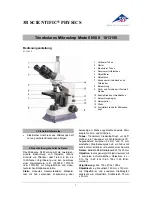
23
Possibilities to improve SNR
Pinhole diameters providing a resolution proba-
bility below 90% may still yield useful images if
one uses a longer pixel time or employs the signal
averaging function. In the former case, additional
photons are collected at each pixel; in the latter
case, each line of the image, or the image as a
whole, is scanned repeatedly, with the intensities
being accumulated or averaged. The influence of
shot noise on image quality decreases as the num-
ber of photons detected increases. As fluores-
cence images in a confocal LSM tend to be shot-
noise-limited, the increase in image quality by the
methods described is obvious.
Furthermore, detector noise, same as laser noise at
high signal levels, is reduced. The figures on the
right show the influence of pixel time (figure 18)
and the influence of the number of signal acquisi-
tions (figure 19) on SNR in [dB]. The linearity
apparent in the semilogarithmic plot applies
to shot-noise-limited signals only. (As a rule,
signals are shot-noise-limited if the PMT high
voltage needed for signal amplification is greater
than 500 V).
A doubling of pixel time, same as a doubling of
the number of signal acquisitions, improves SNR
by a factor of
2 (3 dB). The advantage of the
Figures 18 and 19 Improvement of the signal-
to-noise ratio. In figure 18 (top), pixel time is
varied, while the number of signal acquisitions
(scans averaged) is constant.
In figure 19 (bottom), pixel time is constant,
while the number of signal acquisitions is varied.
The ordinate indicates SNR in [dB], the abscissa
the free parameter (pixel time, scans averaged).
averaging method is the lower load on the speci-
men, as the exposure time per pixel remains con-
stant. Photon statistics are improved by the addi-
tion of photons from several scanning runs (SNR =
n·N; N = const., n = number of scans averaged).
By comparison, a longer pixel time directly
improves the photon statistics by a greater num-
ber N of photons detected per pixel (SNR =
N,
N = variable), but there is a greater probability of
photobleaching or saturation effects of the fluo-
rophores.
Signal Processing
Part 2
34
33
32
31
30
29
28
27
26
25
24
23
22
21
20
1
10
Variation of pixel time
Pixel time
[
s]
SNR
[dB]
2
3
4
34
33
32
31
30
29
28
27
26
25
24
23
22
21
20
1
10
Variation of averages
Number of averages
SNR
[dB]
2
3
4
Fig. 19
Fig. 18
Variation of pixel time
Variation of averages
Number of averages
Pixel time [
s]
34
33
32
31
30
29
28
27
26
25
24
23
22
21
20
34
33
32
31
30
29
28
27
26
25
24
23
22
21
20
SNR
[dB]
SNR
[dB]
337_Zeiss_Grundlagen_e 25.09.2003 16:16 Uhr Seite 26












































